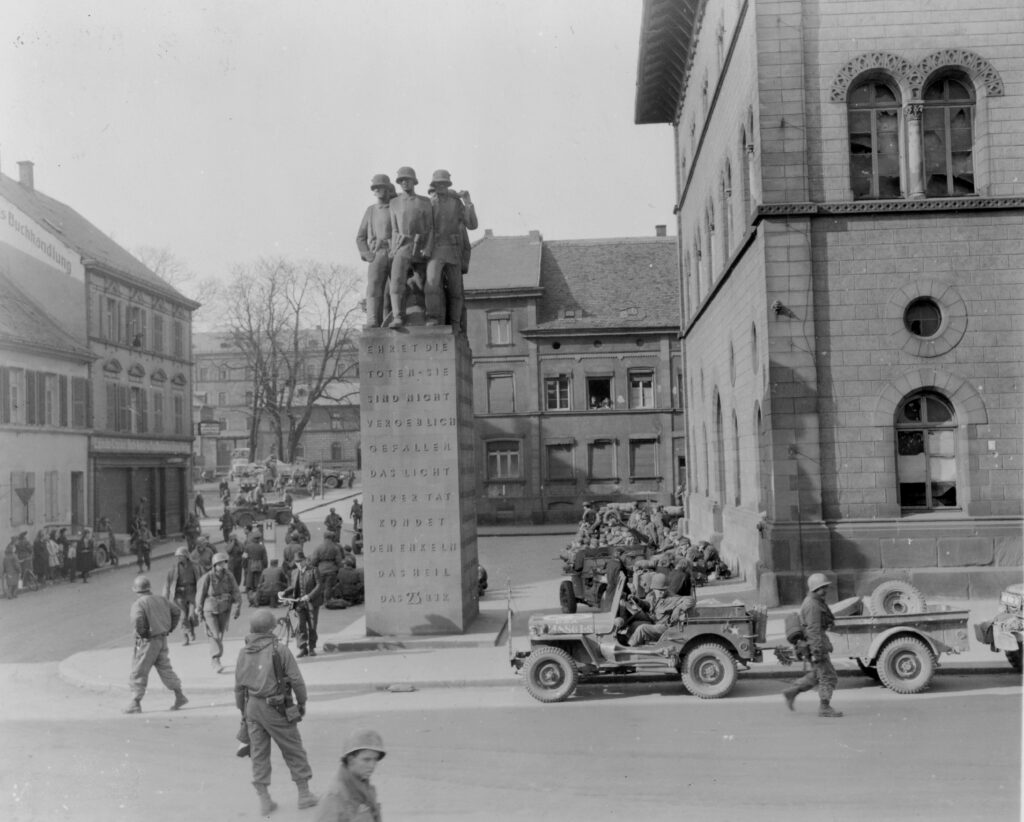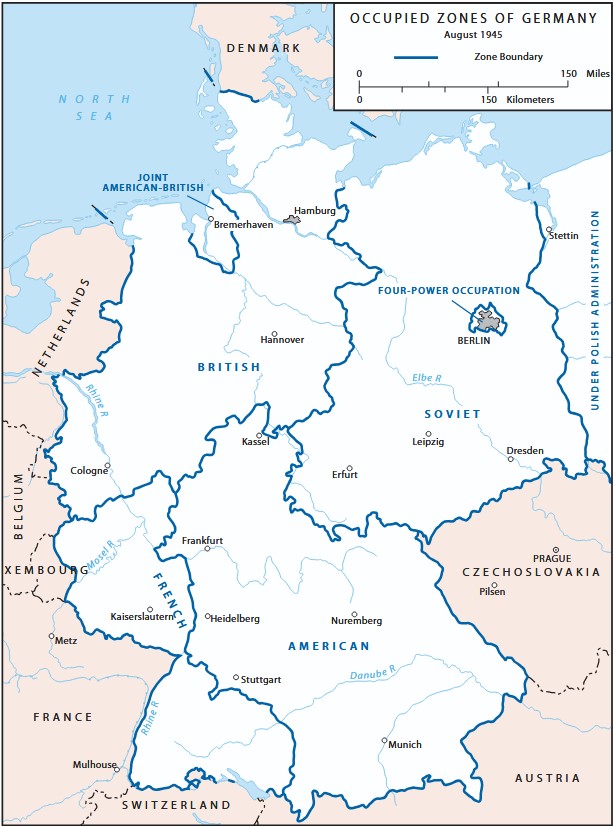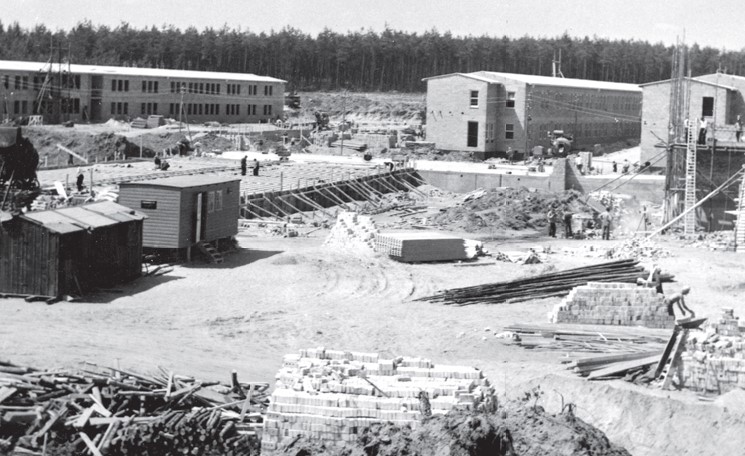The history of the American presence in Kaiserslautern goes back to the closing days of World War 2…

Photo source: Signal Corps Archive via Flickr
Table of Contents
ToggleIntroduction
Welcome to the German city of Kaiserslautern! You may be new to this place, but thousands of Americans before you have come and gone since 1945 and some have even chosen to make this place their home. The history of this place is deep and complex and most Americans who have never lived here have never heard of the Kaiserslautern Military Community. Just know that when you are visiting any given place on this website, you can hear the whispers of those who have come before you. This simple outline will help you listen to those whispers, so read on.
Before 1945
The Celts
Ancient Celtic peoples made this area their home thousands of years ago. But who were the Celts? Most people think of Celts as people who lived in the British Isles, but they were a loose collection of peoples in Western Europe well before the Romans expanded their empire north of Rome.
There are plenty of examples of Celtic artifacts around the KMC: Celtic graves in Rodenbach, the Celtic village near Steinbach am Donnersberg and the Celtic settlement on the Donnersberg.
The Romans
Roman peoples began settling the Rhein River valley during the reign of Julius Ceasar in the 1st century B.C. During the Gallic wars, the Romans fought their way through parts of Western Europe like Gaul (modern day France) and parts of Belgium and western Germany. The Rhein River acted as a bulwark for the north eastern part of the Roman Empire, separating the Roman settlements from the Germanic tribes.
What did the Romans do? They chopped down the thick forests (The Romans were scared to death of the deep, dark German forests: Brothers Grimm anyone?) on the west side of the Rhien River, all the way from Switzerland north to Cologne. They grew grape vines for wine-making where wine is still produced until today. You can tour rebuilt Roman villas where they once made wine. So get out to the Deutsche Weinstrasse or Rhein Hessen and get you some great wine!
Emperor Barbarossa
Many centuries have passed since the fall of the Roman Empire. Frederick I Barbarossa (meaning red beard in Italian) was one of those enigmatic figures in German history. The city of Kaiserslautern was established by Barbarossa as his hunting grounds around 1150. In fact the name “Kaiserslautern” comes from “Kaiser”, the German word for “Emperor” and “Lauter” which is the small river that flows through the city. You can put your feet in this river at the Gartenschau in Kaiserslautern.
Frederick I helped shape the city’s identity and you can tour the ruins of his castle downtown just before you have a burger at the Brauhuas am Markt!
Not only that, the local professional soccer team, 1FC Kaiserslautern, is colloquially known as “die Roten Teufel” or “The Red Devils” and is a nod to the red-bearded Barbarossa. Catch a game at the Betzenberg and watch the fervor of the crowd on the “Westkurv” that will put most American sporting events to shame. Get your tickets now!
1945

The Allied forces had been fighting to get into Germany since D-Day on June 6th, 1944. From the beaches of Normandy through the Ardenne Forest and through the Saar and Rhineland, soldiers fought tooth and nail to advance east towards Berlin. The city of Kaiserslautern was not very strategically important but the city had to be taken. And it was in March 1945.
When the 319th Infantry Regiment of the 80th Division took the city of Kaiserslautern on March 20th, they found that 50 percent of the town had been destroyed by Allied bombing1.
Kaiserslautern was spared the worst of the bombing, compared to other cities like Hamburg and Dresden. However, unlike Dresden, Kaiserslautern had legit targets: the sewing machine company Pfaff A.G. (now the site of a large urban redevelopement project), the railroad switching yard at Einsiedlerhof, the Kammgarnspinnerei and the iron works located near the Betzenberg. Bombing was not exactly accurate and you can still find bomb craters in the woods near Vogelweh Housing and plenty of unexploded ordinance was found near the railroad tracks just north of Pulaski Barracks.
The war in Europe was officially over on May 7th, 1945, however, this would lead to the start of the Cold War and the KMC would play center-stage for NATO strategy in the coming decades. But it would take another historical event to elevate Kaiserslautern to the level of importance it deserved.
The Korean War
Most American installations were located in the eastern part of West Germany, especially in Bavaria. American jets stationed at Neubiberg found themselves only 10 minutes flying time from the Czechoslovakian border which allowed for no time if a war were to break out with the Soviet Block2. With the heightened tensions of the Korea War, it was decided to move to the west of the Rhine River, a natural boundary that would slow down any invading force coming from the east.
Luckily for the Americans, the French had been busy occupying parts of Rheinland-Pfalz and built up some infrastructure3. Many buildings around the Möbel Martin furniture store were built by the French in the late 1940s and are still used today. The Americans needed air bases, so they looked towards Kaiserslautern and a section of the A-6 Autobahn (formerly the Reichsautobahn).
Ramstein Air Base
If you look at Google Maps and you will see that the A-6 Autobahn makes a big curve to the south of RAB. The reason for that is because the USAF used parts of the Autobahn as runways before the rerouting of the A-6 took place. In fact, if you were to drive out the west gate of Ramstein now, you will be driving on the the Reichsautobahn all the way to the CTS area.
When the base first stationed fighter jets in 1953, it was called Landstuhl Air Base.
Landstuhl Regional Medical Center
If you were stationed in Germany, you are familiar with this hospital. Constructed in the early 1950s on the site of a former Wehrmacht kasserne, this medical facility was built in a particular way. If you noticed the odd layout of all the wings sticking out from a central hallway like fingers, that is because the spreadout nature of the wards can minimize damage to the entire facility if part of it was to be bombed.

Built with the Cold War in mind, this place is aging itself out which is why a new facility is currently under construction just outside the former east gate of RAB.
During GWoT, LRMC took center-stage in treating our Wounded Warriors. Frequent medical evacuation flights coming into RAB would tranfer casualties by bus to LRMC and sometimes even to local German hospitals like the Uniklinikum in Homburg. Those were busy times for LRMC staff with the ER triaging the wounded upon arrival.
Economy
The American presence in the KMC is a boon to the local economy. The U.S. military is the largest employer in Kaiserslautern, employing more than 6,000 Germans. The wages for these local workers is over 332 million USD annually4.
Housing for Americans and their families is another source of economic prosperity for the region as well. According to the 86th CPTS, nearly 15,000 American families resided off base in 20105.
Additionally, Americans spend much of their hard-earned income on dining out, cars and products and services provided by local buisnesses.
The American presence is so important to the local economy that when talk of closing military facilities in the KMC was happening in 2003, then mayor of Kaiserslautern, Bernhard Deubig, stated in a Financial Times article that “some cities have coal mines, others had steel mills. We have the Americans.”6
It costs the U.S. government 1 billion USD a year to operate Ramstein and that was according to a New York Times article in 20037. That was before the KMCC was built in the late 2000s! Due to these operating costs, Ramstein sometimes falls into the crosshairs of budget-saving measures.
Needless to say, this is a subject that comes up every decade or so because of Ramstein’s huge footprint. But not to worry! Ramstein has been referred to as “the aircraft carrier of the nation” and has been the jumping off point of multiple post-Cold War operations8.
The Future of the KMC
Despite the talk over the years about closing Ramstein and other bases, the foothold in Germany is important for global reach. The so-called “Aircraft carrier of Europe” should be going nowhere anytime soon, despite its operating costs. But still, enjoy your time in the KMC and get out of your house, your dorm room or your stuffy little appartment as see the wonders that this place has to offer you! Check out our map for something near you.
Sources
- Institut für pfälzische Geschicht und Volkskunde, 2015, Das Ende des Zweiten Weltkrieges in der Pfalz–Vor 70 Jahren: Pfälzer Erleben Kriegsende und Neubeginn, January 10. ↩︎
- Karl-Heinz Rothenberger, 2010, Die Amerikaner in der Pfalz und in Rheinhessen (1950-2010), Vol 24,pg. 28 ↩︎
- Walter G. Rödel, 1995, The Americans Return: From Occupation to Neighborly Relations, in “Nachbar Amerika”, pg. 45. ↩︎
- Zorbach, Jörg. 2013. Kaiserslautern Borderland: Reverberations of the American Leasehold Empire. PhD Diss., Mainzer Studien zur Amerikanistik, Mainz: Peter Lang GmbH, pg. 154. ↩︎
- 86th Comptroller Squadron (CPTS), 2010, KMC Annual Economic Impact Analysis, 3. ↩︎
- Bertrand Benoit, 2003, “K-Town Fears Oblivion if American Forces Move Out: Germany’s Kaiserslautern Depends on a Big US Military Presence for Prosperity, Says Bertrand Benoit”, Financial Times, March 19, pg. 20. ↩︎
- Landler, Mark, 2003, “German City Tries to Persuade Pentagon to Keep Bases Open”, New York Times, November 16. ↩︎
- Sweringen, Bryan, 2010, “The Role of the Rheinland-Palatinate for NATO”, Entagling Alliance: 60 Jahre NATO Geschicte – Gegenwart – Zukunft, Atlantische Akademie, No. 34, pg. 132. ↩︎

